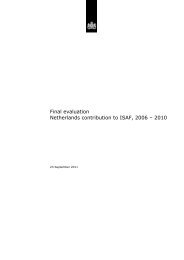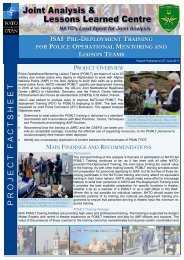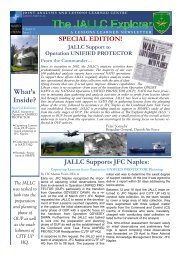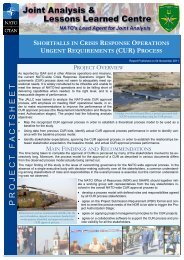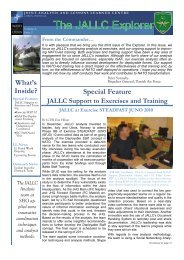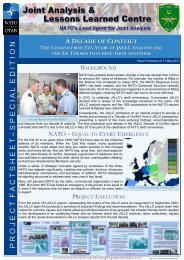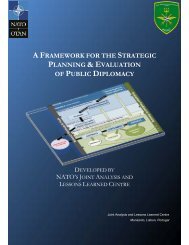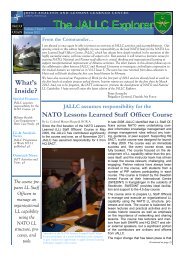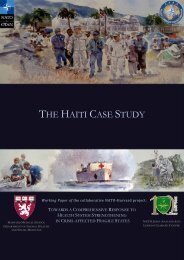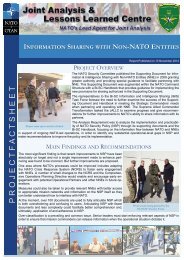read more on Operation Unified Protector Lessons from National ...
read more on Operation Unified Protector Lessons from National ...
read more on Operation Unified Protector Lessons from National ...
You also want an ePaper? Increase the reach of your titles
YUMPU automatically turns print PDFs into web optimized ePapers that Google loves.
P R O J E C T F A C T S H E E T<br />
OPERATION UNIFIED PROTECTOR<br />
LESSONS FROM NATIONAL MILITARY PERSPECTIVES<br />
PROJECT OVERVIEW<br />
In November 2011, the JALLC was tasked by the Supreme Allied Command Transformati<strong>on</strong> to produce an analysis<br />
report <strong>on</strong> Less<strong>on</strong>s Identified during Operati<strong>on</strong> UNIFIED PROTECTOR <strong>from</strong> nati<strong>on</strong>al military perspectives. When this<br />
tasking was assigned, each of the Headquarters involved in the NATO chain of command for OUP had either al<str<strong>on</strong>g>read</str<strong>on</strong>g>y<br />
published its own report of less<strong>on</strong>s or was in the process of preparing <strong>on</strong>e. As a result, this study is a complementary<br />
report that is focused <strong>on</strong> the <strong>on</strong>going Less<strong>on</strong>s Learned process c<strong>on</strong>ducted by Nati<strong>on</strong>s during OUP.<br />
The JALLC collected the observati<strong>on</strong>s and less<strong>on</strong>s identified relevant to<br />
NATO <strong>from</strong> all of the nati<strong>on</strong>s that c<strong>on</strong>tributed forces to the Combined<br />
Joint Task Force UNIFIED PROTECTOR, developing a summary of nati<strong>on</strong>al<br />
perspectives and identifying observed practices and procedures<br />
that enhance NATO’s interacti<strong>on</strong> with nati<strong>on</strong>s and partners supporting<br />
future NATO missi<strong>on</strong>s.<br />
It is important to note that for this study, the JALLC approached all 28<br />
NATO Nati<strong>on</strong>s and the four Operati<strong>on</strong>al Partners associated with OUP.<br />
When the data for this report was assembled, it became <str<strong>on</strong>g>read</str<strong>on</strong>g>ily apparent<br />
that every Nati<strong>on</strong> had a unique list of c<strong>on</strong>cerns that were not necessarily<br />
in line with the priorities of the other Nati<strong>on</strong>s. For this reas<strong>on</strong>, the observati<strong>on</strong>s<br />
of this report are merged in such a way that they are of relevance<br />
to both Nati<strong>on</strong>s and NATO.<br />
Report Published <strong>on</strong> 27 February 2012<br />
The JALLC team during interviews with Nati<strong>on</strong>al<br />
Military Representatives<br />
MAIN FINDINGS AND RECOMMENDATIONS<br />
Ten major observati<strong>on</strong>s are identified in the report. The fact that much of the data reported has al<str<strong>on</strong>g>read</str<strong>on</strong>g>y been addressed<br />
in <strong>on</strong>e or <str<strong>on</strong>g>more</str<strong>on</strong>g> of the NATO produced documents indicates that these are key focus areas for improvement<br />
that will benefit the Alliance and enhance future NATO operati<strong>on</strong>s. This report also c<strong>on</strong>tains two “other observati<strong>on</strong>s”<br />
that while important <strong>from</strong> a Nati<strong>on</strong>al Perspective were determined to be either internal nati<strong>on</strong>al issues or with unspecified<br />
root causes.<br />
A Norwegian F-16 prepares to launch <strong>from</strong> Souda<br />
Air Base in support of OUP<br />
Two of the major observati<strong>on</strong>s are associated with pers<strong>on</strong>nel qualificati<strong>on</strong>s<br />
and rotati<strong>on</strong> rates. Several Nati<strong>on</strong>s reported that pers<strong>on</strong>nel assigned to fill<br />
staff positi<strong>on</strong>s in support of OUP often lacked pre-requisite training and/or<br />
experience resulting in a mismatch of people and skills required, and that<br />
there was a reduced effectiveness of OUP Headquarters due to the frequent<br />
rotati<strong>on</strong> of some assigned pers<strong>on</strong>nel.<br />
Additi<strong>on</strong>al observati<strong>on</strong>s include Standing NATO Commitments, Strategic<br />
Communicati<strong>on</strong>s, Force Preparati<strong>on</strong> and Sustainment, Operati<strong>on</strong>al Partners<br />
with Sp<strong>on</strong>sor Nati<strong>on</strong>s, Informati<strong>on</strong> Sharing, Precisi<strong>on</strong> Guided Muniti<strong>on</strong>s, Air<br />
Tasking Order Cycle, and the lack of Intelligence, Surveillance and Rec<strong>on</strong>naissance<br />
assets.<br />
Within the report, Nati<strong>on</strong>al observati<strong>on</strong>s are cross-referenced with the various NATO Less<strong>on</strong>s Identified/Learned reports<br />
to highlight the importance of these Nati<strong>on</strong>al Perspectives to the Alliance as a whole. The overarching message<br />
is that the soluti<strong>on</strong>s to these challenges in NATO have been c<strong>on</strong>sistently identified, and should find support am<strong>on</strong>g<br />
Nati<strong>on</strong>s, because the nati<strong>on</strong>al will to support NATO changes is paramount.
P R O J E C T F A C T S H E E T<br />
Four ships of NATO's surface Task Group 455 form up for a<br />
brief cerem<strong>on</strong>y to mark the end of OUP <strong>on</strong> 31 October 2011.<br />
PROJECT EXECUTION<br />
LT COLONEL MAREK PRZYMANOWSKI, POLISH AIR FORCE<br />
This report was developed utilizing interviews, corresp<strong>on</strong>dence<br />
and other data that described less<strong>on</strong>s <strong>from</strong> individual Nati<strong>on</strong>s<br />
who c<strong>on</strong>tributed to Operati<strong>on</strong> UNIFIED PROTECTOR. The<br />
JALLC c<strong>on</strong>tacted all 28 NATO members as well as the four<br />
Operati<strong>on</strong>al Partners that participated in OUP military operati<strong>on</strong>s<br />
in order to gain an understanding of their less<strong>on</strong>s <strong>from</strong> a<br />
military perspective and to improve future NATO operati<strong>on</strong>s.<br />
As this data was collected and analyzed, the team researched<br />
NATO’s other reports about OUP in order to identify the areas<br />
that could be addressed to enhance the Alliance’s military ability<br />
to c<strong>on</strong>duct future missi<strong>on</strong>s. This document was produced in<br />
support of the other JALLC report “OUP: Less<strong>on</strong>s for the Alliance”<br />
to show that the c<strong>on</strong>cerns of Nati<strong>on</strong>s walk in step with<br />
the c<strong>on</strong>cerns of NATO.<br />
PROJECT TEAM<br />
LTC Marek Przymanowski has been an analyst officer at the JALLC since August 2010. He has a masters degree<br />
in Electr<strong>on</strong>ics. Having specialized in Ground Based Air Defense, he has held multiple positi<strong>on</strong>s including Fire<br />
C<strong>on</strong>trol Officer as well as a Deputy Technical Commander of a Ground Based Air Defense Squadr<strong>on</strong>. He has a<br />
wealth of Joint and NATO experience, and prior to taking the post at the JALLC, he worked in the Office of Chief<br />
of General Staff Assistant for Air Force Affairs, Poland.<br />
LT COLONEL KARL KRONSKJOLD, DANISH ARMY<br />
LTC Karl Kr<strong>on</strong>skjold is an infantry officer and he has served in the Danish Army since 1982. He is a Senior Staff<br />
Course Graduate <strong>from</strong> the Baltic Defence College. LTC Kr<strong>on</strong>skjold has been deployed to the Former Yugoslavia<br />
and Afghanistan. Since 2008, LTC Kr<strong>on</strong>skjold has been assigned to NATO in Portugal, first for two years at Joint<br />
Command Lisb<strong>on</strong>, and since April 2010 at the JALLC as a military analyst.<br />
LT COMMANDER ANTHONY SMITH, US NAVY<br />
LCDR Smith has served as a pilot in the United States Navy since 1998. He graduated <strong>from</strong> the University of<br />
Washingt<strong>on</strong> with a degree in Computer Engineering. He has flown multiple combat missi<strong>on</strong>s in support of Operati<strong>on</strong><br />
IRAQI FREEDOM and served as the Assistant Air Operati<strong>on</strong>s Officer with Carrier Strike Group THREE in<br />
support of Operati<strong>on</strong> ENDURING FREEDOM. He arrived at the JALLC in 2011.<br />
JALLC<br />
JOINT ANALYSIS AND LESSONS LEARNED CENTRE<br />
AVENIDA TENENTE MARTINS – MONSANTO<br />
1500-589 LISBON<br />
PORTUGAL<br />
PHONE: +351 21 771 7007/8/9<br />
FAX: +351 21 771 7098<br />
MR ARTHUR SOSA, CIVILIAN ANALYST<br />
Mr. Sosa has served as a senior analyst at the JALLC for nearly six years <strong>on</strong> projects influencing NATO<br />
operati<strong>on</strong>s in Kosovo and Afghanistan. He is a former US Army Officer with thirty years experience in command<br />
at all levels. Mr. Sosa graduated <strong>from</strong> the U.S. Army Senior Service College/War College; Command and General<br />
Staff College. He holds a Masters Degree in Educati<strong>on</strong>.<br />
MR DAVID JONES, CIVILIAN OPERATIONAL ANALYST<br />
David J<strong>on</strong>es is an operati<strong>on</strong>al analyst <strong>on</strong> the JALLC Producti<strong>on</strong> Branch's project support and assurance team.<br />
He has a masters degree in Military Operati<strong>on</strong>al Research <strong>from</strong> the UK Royal Military College of Science, with<br />
additi<strong>on</strong>al areas of studies in mathematics, statistics and health & safety. After seven years with BAE Systems he<br />
became a c<strong>on</strong>tractor for the UK Defence Science and Technology Laboratory. David began working for the<br />
JALLC in February 2011.<br />
NATO’S LEAD AGENT FOR JOINT ANALYSIS<br />
All JALLC Reports, the LL Portal, and NATO LLDb Items may be<br />
found in their entirety under the Products secti<strong>on</strong> <strong>on</strong> the NS WAN:<br />
http://www.jallc.nato.int<br />
N<strong>on</strong>-classified reports and LLDb Items, Project FactSheets, the<br />
Joint Analysis Handbook and Less<strong>on</strong>s Learned Handbook can be<br />
found <strong>on</strong> the JALLC’s Internet site at the same address.<br />
A proud member of Allied Command Transformati<strong>on</strong>



